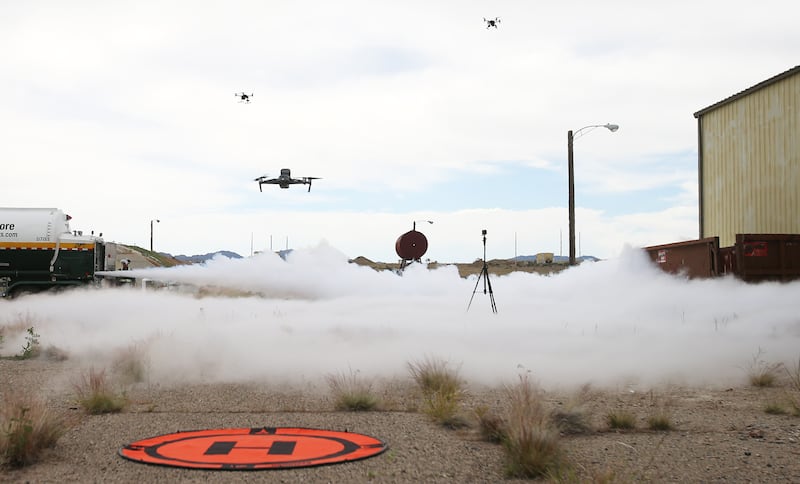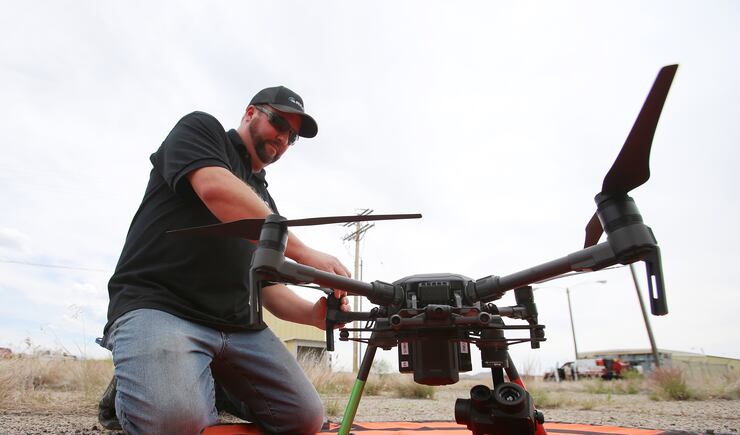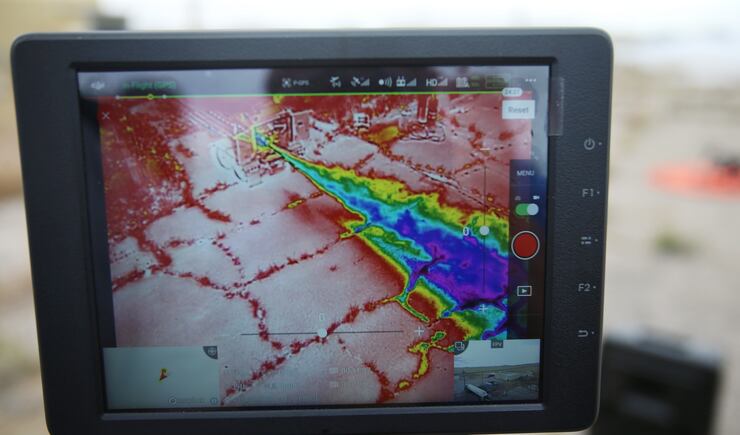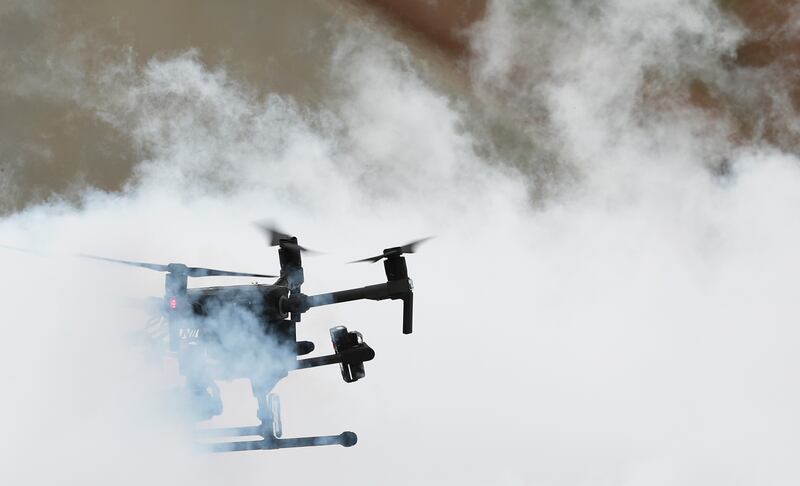SKULL VALLEY, Tooele County — The huge plume of nitrogen gas appears as an otherworldy deep purple cloud on the screen of the drone operator’s remote control console.
The gray, browns and greens of the desolate test site — the same western desert location that once hosted American and Russian officials for the decommissioning of nuclear missiles in the Cold War era — instead appear in vibrant fluorescent tones thanks to thermal imaging software that can also help detect the presence of toxic gases and chemicals.
On this day, the exhibition of drones bearing high-tech gear for responding to hazardous materials incidents are busy detecting nonlethal test gases, but the aircraft are being widely adopted as first-response tools that are keeping emergency personnel out of potentially deadly environments.
While becoming an increasingly effective public safety tool, drones are poised to fundamentally change a much broader civilian landscape, including the transport of hard goods ranging from a must-have product from Amazon to critical medical supplies and, in the very near future, even elevate passenger traffic from clogged and earthbound roadways to the currently unoccupied near-overhead airspace.
Utah is well-positioned to not only be among the leaders of the drone revolution but also bear expansive economic benefits as the new industry takes off.

Tom McMahon is the senior vice president of advocacy and government relations for Association for Unmanned Vehicle Systems International based in Arlington, Virginia. McMahon said thanks to a number of factors, Utah is one of the states leading out on both developing and adopting new drone technology.
”I don’t know any organization that’s actually ranking states, but certainly I’d put Utah near the top if one did exist,” McMahon said.
McMahon said Utah has a geographic advantage in having numerous open spaces and test facilities at which new drone technology can be tested and, additionally, has laid legislative groundwork to help keep the momentum moving forward.
”Utah is one of only about 15 states that have adopted policies of statewide authority for unmanned aerial systems,” McMahon said. “This provides a lot of certainty for companies in the drone space because they know what they’re dealing with.”
McMahon also noted the state recently opened the doors for operation of other autonomous vehicles and has vibrant activity both in private sector development of drones and drone-related technology as well as research happening at Utah colleges and universities.
Even as the hazmat event, which drew dozens of attendees from around the country, was underway, a scale model of a drone capable of vertical takeoffs and landings and traveling at almost 400 mph with seven passengers aboard is waiting in a Box Elder County hangar for final FAA sign-offs for flight testing.
And the University of Utah has work underway that’s likely to make it the first location in the state, and among the first in the country, to have working drones in the air shuttling packages from the school’s medical campus to facilities in Research Park.
Deseret UAS (unmanned aerial systems) is a Utah-based drone industry trade group launched four years ago that is working to become the go-to organization for all things drone in the state. Tooele County Commissioner Shawn Milne is Deseret’s executive director and board chairman and an enthusiastic advocate for the state’s burgeoning drone industry. Milne said while he doesn’t expect passenger- and package-carrying drones to suddenly swarm the skies, he does believe we’re closing in on a pivotal moment.
”By no means do we expect this to explode in the next little bit,” Milne said. “But I do think it’s going to hit the explosive element in the next few decades.
”I think it’s kind of like the early years of automobiles … those formative years where you saw so many companies that came out and said, ‘OK, now that I know the automobile is real, what would be my work.’ And some of them were playing with the three-wheeled vehicle, some of them were focused on cosmetics and the body shape and some were trying to increase horsepower. And I think that’s where we’re at right now. I think it’s an incredibly exciting time.”
Milne said his group is coordinating drone-related business at multiple levels, including convening topic experts at events like the one in June in Skull Valley, providing flight test facilities for developers and bringing the various players in the sector together, all with the forward-looking goal of advancing the industry in Utah.





The state’s flagship university is among the various entities pushing those advancements and is on the bleeding edge of efforts to put drones to work, including aiming to put payload-carrying devices in the air by early next year.
Jim Turnbull, of the University of Utah, said the long-range plan is to have cargo-enabled drones connecting the medical campus with the system’s dozen-plus community health clinics along the Wasatch Front, but first up will be a drone corridor that connects university facilities with Research Park.
Turnbull said his team is working with the Utah Department of Transportation, the Federal Aviation Administration and others in establishing the flightway, which will likely follow the nearby Bonneville Shoreline Trail rather than over the more populated area directly in between campus and the Research Park facilities, southeast of the school.
Turnbull said the effort comes with a host of regulatory and infrastructure challenges and an overarching commitment to safe operations. While much work remains, he said the health system has locked down the vehicle that will be flying the route when it debuts. Matternet, based in Menlo Park, California, has carved out space as a leader in drone-based medical delivery services and earlier this year launched the first FAA-sanctioned revenue drone flights for North Carolina health care system WakeMed.
”We’ve partnered with Matternet, a company that’s been doing this for a while now, staring with delivering for a lab facility in Switzerland,” Turnbull said. “They recently partnered with UPS, who will be in charge of logistics.”
Turnbull said the drones, which can carry up to 10 pounds, will be delivering a large variety of payloads such as medications, lab specimens, medical instruments, blood samples, documents and more. Currently, vehicles are making those deliveries and, Turnbull noted, while the trips from the U. to Research Park take about 15 minutes, a drone can fly the route in about three to four minutes. He said the drone delivery program will not only save time, but help reduce negative air quality impacts by reducing vehicle miles traveled. He also noted the significance of being on track to launch the state’s first functioning drone delivery program, from an economic impact perspective.
”I think the business development opportunity is great,” Turnbull said. “There is a lot of potential in the state to develop applications around this and delivery vehicles as well. I just think that is really exciting.”
“It’s a whole new world when it comes to aerospace manufacturing and there is great potential that we could have one of these in our state.”
Chanel Flores also sees burgeoning economic development opportunities for Utah in the drone space.
Flores is the aerospace and IT cluster director for the Governor’s Office of Economic Development. She said Utah is well-positioned to play host to potential drone manufacturing facilities.
”Traditional aerospace manufacturers are producing a relatively small number of aircraft,” Flores said. “Ahead of the passenger drone market maturing, we will see facilities developed to produce 1,000-1,200 vehicles a year … it will be an entirely new and game-changing approach.”
Flores said Utah already plays host to critical academic research work in the sector as well as aircraft-related manufacturers that specialize in things like composite and advanced materials. She said there is also a growing presence of private companies working on drones and drone-related tech in Utah and noted a leader in lithium battery technology for drones and other electric vehicles recently relocated from California to Logan.
”It’s a whole new world when it comes to aerospace manufacturing and there is great potential that we could have one of these in our state,” Flores said.
Flores said another conversation that’s happening in a state-convened Urban Air Mobility working group is anticipating a time when drones will be ferrying human passengers. XTI Aircraft Co., based in Englewood, Colorado, is set to test a scale-model prototype of its seven-passenger drone at a Northrop Grumman test flight facility in northern Utah. Flores said once operational, passenger-carrying drones could play a vital role in connecting talented prospects in rural Utah with job opportunities that are clustered along the I-15 corridor.
”One of the things we want to focus on when it comes to urban air mobility is how we can connect our rural communities to the urban corridor,” Flores said. “If we’re able to change our transportation system to where we can, for example, transport people from Sanpete County to Utah County in 20 minutes and vice versa … it would be a game-changer.”








